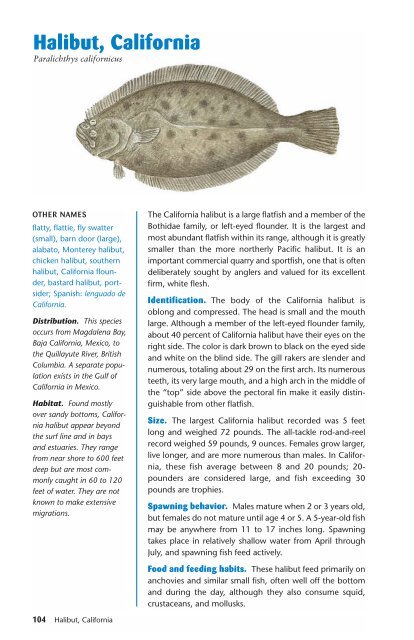Ken Schultz's Field Guide to Saltwater Fish - Macaw Pets store
Ken Schultz's Field Guide to Saltwater Fish - Macaw Pets store
Ken Schultz's Field Guide to Saltwater Fish - Macaw Pets store
You also want an ePaper? Increase the reach of your titles
YUMPU automatically turns print PDFs into web optimized ePapers that Google loves.
Halibut, California<br />
Paralichthys californicus<br />
OTHER NAMES<br />
flatty, flattie, fly swatter<br />
(small), barn door (large),<br />
alaba<strong>to</strong>, Monterey halibut,<br />
chicken halibut, southern<br />
halibut, California flounder,<br />
bastard halibut, portsider;<br />
Spanish: lenguado de<br />
California.<br />
Distribution. This species<br />
occurs from Magdalena Bay,<br />
Baja California, Mexico, <strong>to</strong><br />
the Quillayute River, British<br />
Columbia. A separate population<br />
exists in the Gulf of<br />
California in Mexico.<br />
Habitat. Found mostly<br />
over sandy bot<strong>to</strong>ms, California<br />
halibut appear beyond<br />
the surf line and in bays<br />
and estuaries. They range<br />
from near shore <strong>to</strong> 600 feet<br />
deep but are most commonly<br />
caught in 60 <strong>to</strong> 120<br />
feet of water. They are not<br />
known <strong>to</strong> make extensive<br />
migrations.<br />
104 Halibut, California<br />
The California halibut is a large flatfish and a member of the<br />
Bothidae family, or left-eyed flounder. It is the largest and<br />
most abundant flatfish within its range, although it is greatly<br />
smaller than the more northerly Pacific halibut. It is an<br />
important commercial quarry and sportfish, one that is often<br />
deliberately sought by anglers and valued for its excellent<br />
firm, white flesh.<br />
Identification. The body of the California halibut is<br />
oblong and compressed. The head is small and the mouth<br />
large. Although a member of the left-eyed flounder family,<br />
about 40 percent of California halibut have their eyes on the<br />
right side. The color is dark brown <strong>to</strong> black on the eyed side<br />
and white on the blind side. The gill rakers are slender and<br />
numerous, <strong>to</strong>taling about 29 on the first arch. Its numerous<br />
teeth, its very large mouth, and a high arch in the middle of<br />
the “<strong>to</strong>p” side above the pec<strong>to</strong>ral fin make it easily distinguishable<br />
from other flatfish.<br />
Size. The largest California halibut recorded was 5 feet<br />
long and weighed 72 pounds. The all-tackle rod-and-reel<br />
record weighed 59 pounds, 9 ounces. Females grow larger,<br />
live longer, and are more numerous than males. In California,<br />
these fish average between 8 and 20 pounds; 20pounders<br />
are considered large, and fish exceeding 30<br />
pounds are trophies.<br />
Spawning behavior. Males mature when 2 or 3 years old,<br />
but females do not mature until age 4 or 5. A 5-year-old fish<br />
may be anywhere from 11 <strong>to</strong> 17 inches long. Spawning<br />
takes place in relatively shallow water from April through<br />
July, and spawning fish feed actively.<br />
Food and feeding habits. These halibut feed primarily on<br />
anchovies and similar small fish, often well off the bot<strong>to</strong>m<br />
and during the day, although they also consume squid,<br />
crustaceans, and mollusks.


